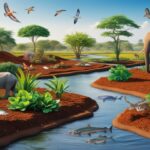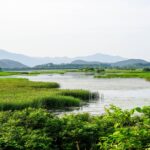Climate change impact on biodiversity is a pressing concern as our planet undergoes unprecedented shifts in environmental dynamics. The intricate dance of life, finely tuned to specific climatic conditions, now faces a formidable challenge.
Rising temperatures, altered precipitation patterns, and extreme weather events disrupt ecosystems, leaving a profound impact on the flora and fauna that inhabit them.
As species struggle to adapt or migrate to more suitable habitats, the delicate balance of biodiversity is at risk. This not only threatens individual species but also poses a threat to entire ecosystems.
Understanding the nuanced ways in which climate change influences the diverse tapestry of life on Earth is crucial for devising effective conservation measures and ensuring the resilience of our planet’s ecological heritage.
Climate Change and Biodiversity
Climate change refers to long-term alterations in global or regional temperature and weather patterns, primarily driven by human activities such as the burning of fossil fuels and deforestation.
Biodiversity, the variety of life on Earth, is intricately linked to climate conditions. Different species have evolved and adapted to specific climates, creating a delicate balance within ecosystems.
The dependence of biodiversity on climate is evident in the behaviors and life cycles of various species. Plants, for example, rely on specific temperature and precipitation conditions for optimal growth and reproduction.
Animals, too, depend on climate cues for migration, breeding, and feeding. As climate change leads to shifts in temperature, altered precipitation patterns, and more frequent extreme weather events, the delicate balance of ecosystems is disrupted.
Many species struggle to adapt or migrate to more suitable environments, leading to population declines and, in some cases, extinction.
Recognizing the intricate relationship between climate change and biodiversity is crucial for devising effective conservation strategies and preserving the diverse array of life on our planet.
Effects of Climate Change on Biodiversity
Climate change impact on biodiversity occurs across terrestrial, aquatic, and aerial ecosystems. On land, rising temperatures alter habitats and disrupt migration patterns, affecting various species.
The Intergovernmental Science-Policy Platform on Biodiversity and Ecosystem Services (IPBES) reports that approximately 1 million animal and plant species are currently at risk of extinction, with climate change being a key driver.
Water ecosystems, both freshwater and marine, witness the consequences of climate change through ocean acidification, coral bleaching, and altered currents. These changes endanger marine life, including iconic species like polar bears and coral reefs.
In the air, migratory patterns of birds and insects are disrupted, impacting pollination and seed dispersal. According to the World Wildlife Fund (WWF), climate change is a significant threat to nearly half of all bird species.
The intricate web of life faces unprecedented challenges, and the loss of biodiversity has cascading effects on ecosystems and human societies.
The Global Assessment Report on Biodiversity and Ecosystem Services highlights that up to $577 billion in annual global crops are at risk due to pollinator loss, a consequence of climate change impacts on biodiversity.
As we witness a decline in biodiversity on land, in water, and in the air, urgent and collective action is essential to mitigate climate change and preserve the rich variety of life on Earth.
Also Read: Natural Vegetation Types in India [A Guide]
How Climate Change Affect Biodiversity
Climate change affect biodiversity in many ways:
Habitat Disruption: Climate change alters temperature and precipitation patterns, leading to shifts in ecosystems and disrupting the habitats where various species thrive.
Species Migration: Rising temperatures prompt many species to migrate in search of suitable climates, affecting the distribution and interaction of plant and animal populations.
Extreme Weather Events: Increased frequency of extreme weather events, such as hurricanes and droughts, poses direct threats to biodiversity by destroying habitats and diminishing food sources.
Ocean Acidification: Climate change contributes to ocean acidification, impacting marine life, particularly coral reefs and shell-forming organisms, with cascading effects on the entire aquatic food web.
Polar Regions Impact: Rapid melting of polar ice due to global warming affects species like polar bears and penguins, challenging their traditional ways of life and survival.
Altered Reproduction Cycles: Changes in temperature and environmental conditions affect the reproductive cycles of many species, potentially leading to imbalances in population dynamics.
Impact on Food Chains: Disruptions in biodiversity have far-reaching consequences on food chains, as changes in one species can affect the entire ecosystem, with implications for human societies dependent on these ecosystems.
Climate Change Causing Agents
Two main causes of climate change are:
1. Emission of Greenhouse Gases
Greenhouse gases (GHGs) are gases in the Earth’s atmosphere that trap heat, creating the greenhouse effect. The primary GHGs include carbon dioxide (CO2), methane (CH4), nitrous oxide (N2O), and fluorinated gases.
Human activities, such as burning fossil fuels for energy, deforestation, and industrial processes, significantly contribute to the release of these gases into the atmosphere.
The combustion of coal, oil, and natural gas for energy remains a major source of CO2 emissions, while agricultural practices and waste management contribute to methane and nitrous oxide emissions.
2. Deforestation
Deforestation refers to the large-scale removal or clearing of forests, primarily driven by human activities. This process involves cutting down trees for various purposes, such as agriculture, logging, or urban development.
The expansion of agricultural land, logging for timber, and the demand for wood products contribute significantly to deforestation. In some cases, forests are cleared for infrastructure development or to make way for industrial activities.
The methods used in deforestation often include clear-cutting, slash-and-burn techniques, and logging, leading to the rapid and extensive loss of forest cover.
How Greenhouse Gases Affect Temperature and Biodiversity?
Greenhouse gases play a crucial role in regulating Earth’s temperature. While the sun’s energy reaches the Earth in the form of sunlight, some of this energy is reflected back into space, while the rest is absorbed and re-radiated as heat.
Greenhouse gases trap a portion of this heat, preventing it from escaping into space and keeping the Earth’s surface warm. However, human activities have led to an excess of these gases, intensifying the greenhouse effect.
This enhanced trapping of heat raises global temperatures, resulting in climate change. The Intergovernmental Panel on Climate Change (IPCC) reports that the global average temperature has increased by approximately 1.1 degrees Celsius since the pre-industrial era.
Beyond their role in temperature regulation, greenhouse gases contribute to various environmental challenges. Ocean acidification, driven by the absorption of excess atmospheric CO2 by the oceans, poses a threat to marine ecosystems and biodiversity.
Changes in precipitation patterns, more frequent and severe weather events, and rising sea levels are additional consequences of the increased concentration of greenhouse gases.
Mitigating these impacts requires global efforts to reduce emissions through sustainable practices, renewable energy adoption, and improved land use management.
Addressing the complexities of greenhouse gas emissions is vital for ensuring a more stable and sustainable future for our planet.
How Deforestation Affects the Environment and Biodiversity?
Deforestation has severe and far-reaching consequences for the environment and biodiversity. The removal of trees diminishes the ecosystem’s ability to absorb carbon dioxide from the atmosphere, contributing to increased greenhouse gas levels and climate change.
Loss of habitat is a critical issue, affecting countless plant and animal species that depend on forests for survival. This disruption in habitat leads to the decline and, in some cases, extinction of various species.
Deforestation also contributes to soil erosion, affecting agricultural productivity and leading to the degradation of once-fertile lands. Moreover, the removal of trees reduces the regulation of water cycles, leading to altered rainfall patterns and increased vulnerability to floods.
Deforestation not only impacts the environment but also affects local communities that depend on forests for their livelihoods. Indigenous populations often face displacement, loss of cultural heritage, and challenges to their traditional ways of life.
Additionally, deforestation contributes to the loss of biodiversity and the disruption of ecosystems, which can have cascading effects on global biodiversity and ecological balance.
Sustainable forest management practices, afforestation, and reforestation efforts are crucial to mitigating the adverse impacts of deforestation and preserving the vital role that forests play in maintaining the health of our planet.
Other things that impact biodiversity are:
Water Pollution
Water pollution is the contamination of water bodies, such as rivers, lakes, and oceans, with harmful substances.
Human activities, including industrial discharges, agricultural runoff, and improper waste disposal, introduce pollutants like chemicals and nutrients into water sources.
This pollution negatively impacts biodiversity by harming aquatic ecosystems. Marine life, including fish and other organisms, can suffer from toxic substances, leading to population declines and disruptions in the food chain.
Additionally, polluted water affects the quality of drinking water, posing risks to human health.
Soil Pollution
Soil pollution refers to the presence of pollutants in the soil, often resulting from industrial activities, agricultural practices, and improper waste disposal.
Harmful chemicals, heavy metals, and pesticides can contaminate the soil, affecting plant growth and disrupting the balance of ecosystems.
Soil pollution has detrimental effects on biodiversity as it can lead to the decline of soil-dwelling organisms, including beneficial microbes and insects.
This disruption in the soil ecosystem cascades to impact larger organisms and can result in the loss of plant and animal species.
Air Pollution
Air pollution involves the release of harmful substances into the air, primarily due to human activities such as industrial processes, vehicle emissions, and the burning of fossil fuels.
Air pollution adversely affects biodiversity by harming both plant and animal life. High concentrations of pollutants like particulate matter and nitrogen oxides can damage plant tissues and hinder photosynthesis.
In animals, respiratory issues may arise, leading to population declines. Birds and insects, crucial for pollination and seed dispersal, can also be affected.
Overall, air pollution contributes to the decline of biodiversity by altering ecosystems and disrupting the delicate balance of life.
Global Measures for Conservation of Biodiversity
Efforts to conserve biodiversity globally include a range of measures aimed at mitigating various threats such as climate change, deforestation, and pollution.
International agreements and protocols, such as the Paris Agreement, focus on reducing greenhouse gas emissions to combat climate change. Conservation organizations collaborate on reforestation projects, promoting sustainable forestry practices to counter deforestation.
Additionally, there are global initiatives to address water and air pollution through regulatory frameworks and sustainable practices. Protected areas, both on land and in oceans, play a crucial role in preserving biodiversity, safeguarding habitats, and allowing species to thrive.
These measures require collaborative action among nations, industries, and communities to ensure the sustainability of ecosystems and the well-being of diverse species.
Our Duties to Preserve Biodiversity
Preserving biodiversity is a shared responsibility that extends beyond governments and organizations to individuals. Our duties include adopting sustainable practices in daily life, such as reducing waste, conserving energy, and supporting eco-friendly products.
Raising awareness about biodiversity’s importance and the impact of human activities is essential. Responsible consumption choices, ethical tourism, and habitat protection contribute to the collective effort.
Education and advocacy play a crucial role in promoting biodiversity conservation, emphasizing the interconnectedness of all life on Earth and the importance of maintaining a harmonious balance for current and future generations.
Conclusion
The delicate web of life on our planet is closely connected to the balance of biodiversity. As we face challenges like climate change, deforestation, and pollution, it’s crucial to understand our shared responsibility in protecting the variety of species and ecosystems.
As climate change impact on biodiversity global efforts, like international agreements and conservation projects, are vital for addressing threats to biodiversity. At the same time, individual actions, from mindful consumption to supporting eco-friendly practices, make a significant impact.
Our duties extend beyond our daily lives, involving a collective commitment to the well-being of the Earth and its diverse inhabitants.
By raising awareness, adopting responsible habits, and fostering a harmonious relationship with nature, we can work towards a sustainable future where biodiversity thrives for generations to come.








